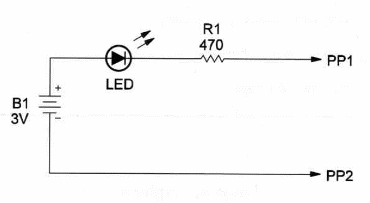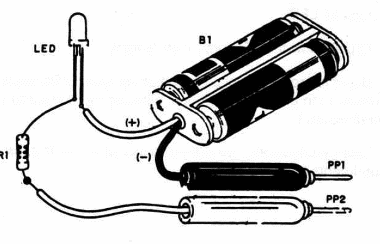This ultra-simple probe can be used to test almost every electronic component.
Capacitors, resistors, fuses, switches, coils, transformers, diodes, wires, etc, can be tested with this simple circuit.
Only three components are used and they can easily be housed in a small plastic box, performing as a portable unit.
The circuit consists basically of a continuity tester with a visual indication by an LED. If current can flow between the probes the LED glows; if not, the LED remains off.
Current flowing between probes is very low to avoid overloading the tested components.
A schematic diagram ofthe Universal Probe is shown in Figure 1.

As you can see, only three electronic components are used in this project.
A components layout view is shown in Figure 2.

The components can be housed in a small box and no ON-OFF switch is necessary.
When mounting, take care with position of the two polarized components, the LED and power supply.
The power supply consists of two AA cells.
An ON-OFF switch is not necessary, as the circuit is off when the probes are separated.
Current through the component under test is determined by the voltage drop across the LED (about 1.6V for red LEDs and 1.8V for yellow LEDs), and resistance of R1.
Universal Probe
LED - Common red, green or yellow LED
R1 - 470 ohm, ¼ W, 5% resistor
PP1, 2 - Red and black probes
B1 - 3V - two AA cells
Science projects:
Use this probe in to find materials that conduct or do not conduct electric current. Several other simple experiments in electricity can be conducted using this probe: for example, show how a switch works, or how a potentiometer used as a rheostat controls the current flow accross an LED.
Explain how the LED produces its light.
Use this probe to explain how a diode works. (Remember that DC is used in the probes and diodes, allowing the current to flow only in one direction.)
This circuit can also be used as a monochromatic source of light in experiments involving optics.




